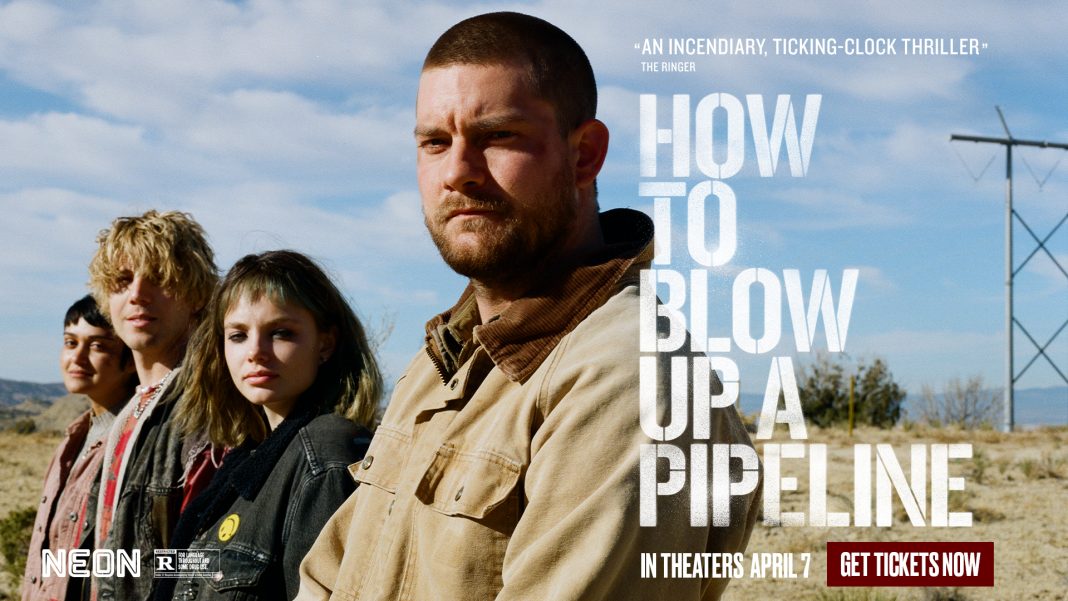“If the American Empire calls us terrorists, then we’re doing something right.”
The oil industry accounts for 9% of the world’s human-made greenhouse gasses, and produces the fuels that make up another 33% of its emissions. Quite fittingly, How To Blow Up A Pipeline - directed by Daniel Goldhaber and co-written with Ariela Barer and Jordan Sjol - starts off with foreboding music in the background of a young person slashing the tires of a large SUV. This isn’t an act of spite, it’s a symbol of rebellion and subversion - setting the stage to explore the main themes of the movie. How To Blow Up A Pipeline is not a tutorial, but rather the story of eight young people who feel strongly about the climate crisis and are searching for justice and catharsis in their own way. The screenwriters and director intended for it to be somewhat of a “heist” movie, using its non-linear narrative to separately explore each character’s background and suspensefully create fragments of a puzzle that slowly come together at the end.
The purpose of the movie was to take the idea presented in the original nonfiction by Andreas Malm, a Swedish Marxist author and Professor of Human Ecology at Lund University, and transcribe it to lived experiences and three dimensional characters. It delves into the individual history, background and identity of each character to give them individual motives that bind them to the collective goal. The film also represents marginalized groups that have a relatively insignificant carbon footprint, but bear the brunt of the climate crisis. Thus, while the top 1% of society contribute the most to environmental destruction, they remain shielded from its effects, leaving it up to the underdogs to fight back. At risk of spoiling the film, it is worthwhile to note that the people who are affected are faced with severe terminal illnesses, unanticipated and sudden death, infringement of private property rights, and prison sentences as a consequence of unequal power dynamics and classist societal structures.
The movie further touches on the fact that divestment and market solutions as a form of environmentalism are too slow and dissatisfactory, calling for more direct and immediate action. While the larger environmental movement is more peaceful and focuses on silent activism, How To Blow Up A Pipeline will make you wonder whether it is the most effective form of environmentalism. Technically, blowing up a section of an oil pipeline – or property destruction – can be construed as an act of violence, but the characters are vehemently against harming other people as collateral damage. In fact, two even go to the lengths of leading unknowing people in danger away from it. However, a co-writer admitted that if it had been one of the other characters, the fate of those people would probably have been different. Similar to the multi-layered personalities and moral compasses of each character, the actors also had different reasons for being a part of this movie but collaborated towards the same goal.
Subtle symbols, such as a dead bird lying next to the pipeline, further tried to emphasize the severity of the climate emergency, added to by mentions of acid rain and one character admitting that they were out of drinking water at home. The acquisition of funding for the film was unconventional, involving sneaking into high profile celebrity events but bolstered by professors and mentors, as well as author Andreas Malm himself. The crew networked and gathered people to put the final product together. Furthermore, Foley sounds in the scenes were created originally, and props and set were also intricately constructed - the main pipeline itself was made entirely of cardboard. The message that one of the co-writers wanted to convey, apart from the obvious ones, was how taxing it is to actually make a movie of this kind, and the kind of mental and physical effort that goes behind it.
A faculty-led discussion on the ethical questions surrounding the film touched on the impact of the Anthropocene on climate awareness, the effect of the film on their personal moral values, and the inherent privilege in being able to lose one's livelihood for the cause. I would argue that the last point fails to include the sheer rage and injustice that fuels the sacrifice of one’s freedom for something they believe in, like the characters Xotchil and Theo did in the movie. Moreover, the establishment of the Anthropocene as an acknowledgement of humanity’s egregious influence on the environment was meant to reorient us to the threat that climate change is posing but has not had its desired effect on the general public. To make matters worse, those in power continue in ignorance to fund and run large corporations that add to climate change, while people from a lower socioeconomic status fight back to little avail.
In a world where living sustainably – or, in simpler terms, in a way that preserves the resources needed for future generations to survive – is of paramount importance. It is heartbreaking to see how little people actually care about the planet. How To Blow Up A Pipeline is a call to action, a story of real experiences, but, most of all, a raw revelation of humanity’s sad truth.

